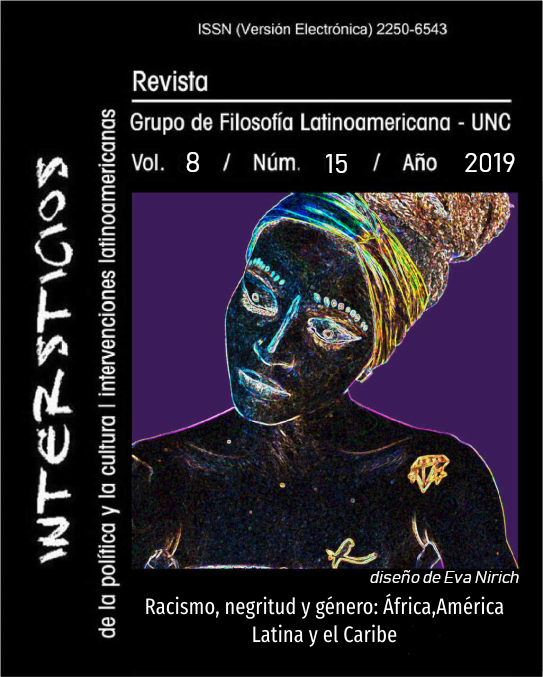Las olvidadas del bicentenario: Feminismos y culturas afroamericanas detrás de un mural en Dolores
Palabras clave:
mural, feminismo, afrodescendientes, poscolonialidad, patrimonioResumen
El olvido -cara opuesta o revés de la trama de la memoria histórica- es una forma de protección y camuflaje porque al postular un enunciado como el único válido se obtura la posibilidad de emergencia de otros posibles. No obstante, desde los intersticios, rebrotan los enunciados subalternos para cuestionar la universalidad de la hegemonía y ofrecer alternativas que permitan recordar que la construcción social de la realidad es un proceso complejo, lleno de voces contradictorias y, por eso mismo, abierto a múltiples posibilidades de respuestas y sentidos capaces de abrir numerosos atajos a lo posible.
El mural “Las olvidadas del bicentenario” pintado en la pared de una escuela en Dolores, ciudad bonaerense situada a mitad de camino entre Buenos Aires y Mar del Plata, a pesar de sus exiguas dimensiones -1,30 m por 1, 50 - en primer lugar, promueve interrogantes acerca de la ausencia de la mujer afrodescendiente en los festejos por el Bicentenario de la fundación de aquel pueblo en 2017 y, en segundo término, invita a la reflexión en torno a la naturalización del olvido de las culturas afroamericanas en la narración de la historia local.
Se conjetura que tal omisión es el resultado de la pereza intelectual que impide a los guardianes de la memoria local plantearse nuevas preguntas acerca del sentido. Pero, asimismo, esa supresión se articula con otra de mayor envergadura: un absoluto desconocimiento sobre la existencia del Decenio Internacional de los Afrodescendientes, que bajo el tema “Afrodescendientes: reconocimiento, justicia y desarrollo”, comenzó el 1 de enero de 2015 y terminará el 31 de diciembre de 2024 establecido por la Asamblea General de las Naciones Unidades el 30/12/2013.
Descargas
Referencias
Andalzúa, G.(1981): Borderland. La Frontera. The new mestiza. Aunt Lute Books, San Francisco.
Bidaseca, K. (2015): Escritos en los cuerpos racializados. Lenguas, memoria y genealogías (pos)colonilaes del feminicidio. Edicions Universitat de les Illes Balears, España.
Elizalde, F. (1980). La heredad. Corregidor, Buenos Aires.
Korn, F. (1974). Los huéspedes del 20. Sudamericana, Buenos Aires.
Mascioli, A. (2002): ‘Caminos de acceso al usufructo y propiedad legal de la tierra en la frontera bonaerense. Dolores, 1798-1860”.
Revista Quinto Sol, No 6. Recuperado de: https://cerac.unlpam.edu.ar/index.php/quintosol/article/view/673
Meo Laos, V. G. (10/2013). La gestión de los espacios funerarios: El caso del cementerio de Dolores. Trabajo presentado en XIV Encuentro Iberoamericano de valoración y gestión de cementerios patrimoniales y 10a Reunión Nacional de la Red Mexicana de Estudio de Espacios y Cultura Funerarios, Ciudad de México.
Norá, P. ¨ La aventura de Les lieux de mémoire” en Revista Ayer No. 32. Dialnet, 1998. Recuperado de: https://introduccionalahistoriajvg.wordpress.com/2013/07/28/%E2%9C%8D-les-lieux-de-memoire-la-republique-la-nation-les-france-1984-1992/
Pirali, J. C. (2010). Dolores. Reseña de una ciudad con historia. Club Argentino de Servicios 2 de abril, Dolores.
Padula, A. A. y Meo Laos, V. G. (10/ 2012). Viejas y nuevas élites. Una aproximación a las tensiones sociales en el cementerio de Dolores. El valor pedagógico del espacio funerario. Trabajo presentado en V Jornadas Nacionales de Patrimonio Simbólico en Cementerios, Rosario, Argentina.
Padula, A. A. y Meo Laos, V. G. (10/ 2012). La lápida de Bertha Smith: un ejemplo de devoción popular. Trabajo presentado en V Jornadas Nacionales de Patrimonio Simbólico en Cementerios, Rosario, Argentina.
Quijano, A.. “Qué tal raza!”. Publicado en América Latina en Movimiento, No. 320: <http://alainet.org/publica/320.phtml>. Recuperado de: <http://alainet.org/active/929&lang=es>, el 22 de agosto de 2011.
Descargas
Archivos adicionales
Publicado
Número
Sección
Licencia
Aquellos autores/as que tengan publicaciones con esta revista, aceptan los términos siguientes:- Los autores/as conservarán sus derechos de autor y garantizarán a la revista el derecho de primera publicación de su obra, el cuál estará simultáneamente sujeto a la Licencia de reconocimiento de Creative Commons que permite a terceros compartir la obra siempre que se indique su autor y su primera publicación esta revista.
- Los autores/as podrán adoptar otros acuerdos de licencia no exclusiva de distribución de la versión de la obra publicada (p. ej.: depositarla en un archivo telemático institucional o publicarla en un volumen monográfico) siempre que se indique la publicación inicial en esta revista.
- Se permite y recomienda a los autores/as difundir su obra a través de Internet (p. ej.: en archivos telemáticos institucionales o en su página web) después del proceso de publicación, lo cual puede producir intercambios interesantes y aumentar las citas de la obra publicada. (Véase El efecto del acceso abierto).











